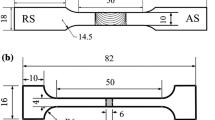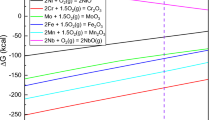Abstract
During the fabrication of fuel tanks by adopting friction stir welding (FSW), welding defects were almost unavoidable. The multi-pass repair FSW is the preferred repair welding technique for fuel tanks. However, the effect of muti-pass repair FSW on the microstructure and mechanical properties of dissimilar FSW 2219Al/2195Al joints lacks of investigation. In the present study, 2219Al-T8/2195Al-T8 plates were subjected to 1 ~ 3 passes repair FSW under 600 rpm–200 mm min−1 based on the initial joint 800 rpm–200 mm min−1 with placing 2219Al-T8 plates on the advancing side (AS). The results showed that, sound 1–3 passes repair FSW joints were obtained. The low hardness zone (LHZ) on the 2219Al-T8 side, characterized by the dissolution/coarsening of θ′ (Al2Cu) precipitates, showed the minimum hardness in the initial joint. Compared to the initial joint, the 1–3 passes repair FSW resulted in the moving of the location of LHZs far away from the weld center and coarser θ precipitates with higher density, and the hardness of the LHZ therefore decreased on the 2219Al-T8 side. The joint strength at − 196 °C was much higher than that at room temperature for both the initial and repair FSW joints. The 1 pass repair FSW weakened the joint strength at both the room temperature and − 196 °C. When increasing the repair pass from 1 to 2 and 3, the joint strength further decreased at room temperature but was unchanged at − 196 °C. The enlarged hardness gap between the nugget zone (NZ) and LHZ caused the narrowing of the necking zone at the LHZ on the 2219Al-T8 side for the multi-pass repair FSW joints. The material flow uniformity at the top of the NZ was improved by the 1 ~ 3 passes repair FSW, making the up bending failure location changing from the “S” line for the initial joint to the HAZ on the 2195Al-T8 side for the repair FSW joints.















Similar content being viewed by others
Explore related subjects
Discover the latest articles, news and stories from top researchers in related subjects.Data availability
The data that support the findings of this study are available from the corresponding author upon reasonable request.
Abbreviations
- FSW:
-
Friction stir welding
- BM:
-
Base material
- NZ:
-
Nugget zone
- TMAZ:
-
Thermal–mechanically affected zone
- HAZ:
-
Heat affected zone
- SDZ:
-
Shoulder driven zone
- PDZ:
-
Pin driven zone
- LHZ:
-
Low hardness zone
- DIC:
-
Digital image correlation
- TEM:
-
Transmission electron microscopy
- SEM:
-
Scanning electron microscopy
- YS:
-
Yield strength
- UTS:
-
Ultimate tensile strength
- EL:
-
Elongation
- AS:
-
Advancing side
- RS:
-
Retreating side
References
Xu WF, Liu JH, Luan GH, Dong CL (2009) Temperature evolution, microstructure and mechanical properties of friction stir welded thick 2219-O aluminum alloy joints. Mater Des 30(6):1886–1893. https://doi.org/10.1016/j.matdes.2008.09.021
Wang G, Zhao Y, Hao Y (2018) Friction stir welding of high strength aerospace aluminum alloy and application in rocket tank manufacturing. J Mater Sci Technol 34(1):73–91. https://doi.org/10.1016/j.jmst.2017.11.041
Mishra RS, Ma ZY (2005) Friction stir welding and processing. Mater Sci Eng R 50(1–2):1–78. https://doi.org/10.1016/j.mser.2005.07.001
Chen GQ, Yin QX, Zhang G, Zhang BG (2020) Fusion–diffusion electron beam welding of aluminum–lithium alloy with Cu nano–coating. Mater Des 188:108439. https://doi.org/10.1016/j.matdes.2019.108439
Kang J, Si MY, Wang JJ, Zhou L, Jiao XD, Wu AP (2023) Effect of friction stir repair welding on microstructure and corrosion properties of 2219–T8 Al alloy joints. Mater Character 196:112634. https://doi.org/10.1016/j.matchar.2022.112634
Mahto RP, Kumar R, Pal SK (2020) Characterizations of weld defects, intermetallic compounds and mechanical properties of friction stir lap welded dissimilar alloys. Mater Charact 160:110115. https://doi.org/10.1016/j.matchar.2019.110115
Guan W, Zhao YH, Liu YC, Kang S, Wang DP (2022) Force data–driven machine learning for defects in friction stir welding. Scr Mater 217:114765. https://doi.org/10.1016/j.scriptamat.2022.114765
Xu XL, Liu QY, Qi S, Hou HL, Wang J, Ren XP (2021) Effect of incomplete penetration defects on mechanical and fatigue properties of friction–stir–welded 6802–T6 joint. J Mater Res Technol 15:4021–4031. https://doi.org/10.1016/j.jmrt.2021.10.028
Liu HJ, Hu YY, Wang H, Du SS, Sekulic DP (2018) Stationary shoulder supporting and tilting pin penetrating friction stir Welding. J Mater Proc Tech 255:596–604. https://doi.org/10.1016/j.jmatprotec.2018.01.010
Zhou L, Han K, Liu C, Huang C (2016) Repair welding of defects in 2219 Al alloy friction stir welded joints. J Aeronaut mater 36(1):26–32
Li WP, Liang ZM, Cai CW, Wang DL (2018) Repair welding of the tunnel defect in friction stir weld. High Temp Mater Proc 37(7):675–681. https://doi.org/10.1515/htmp-2017-0026
Brown R, Tang W, Reynolds AP (2009) Multi-pass friction stir welding in alloy 7050–T7451: effects on weld response variables and on weld properties. Mater Sci Eng A 513–514(15):115–121. https://doi.org/10.1016/j.msea.2009.01.041
Robson JD, Upadhyay P, Reynolds AP (2010) Modelling microstructural evolution during multiple pass friction stir welding. Sci Technol Weld J 15(7):613–618. https://doi.org/10.1179/136217110X12813393169651
Tao Y, Zhang Z, Yu BH, Xue P, Ni DR, Xiao BL, Ma ZY (2020) Friction stir welding of 2060–T8 Al Li alloy. Part I: microstructure evolution mechanism and mechanical properties. Mater Charact 168:110524. https://doi.org/10.1016/j.matchar.2020.110507
Wang ZL, Zhang Z, Xue P, NI DR, Ma ZY, Hao YF, Zhao YH, Wang GQ, (2022) Defect formation, microstructure evolution, and mechanical properties of bobbin tool friction-stir welded 2219–T8 alloy. Mater Sci Eng A 832:142414. https://doi.org/10.1016/j.msea.2021.142414
Zhang Z, Xiao BL, Ma ZY (2022) Enhancing mechanical properties of friction stir welded 2219Al–T6 joints at high welding speed through water cooling and post-welding artificial ageing. Mater Character 106:255–265. https://doi.org/10.1016/j.matchar.2015.06.003Getrightsandcontent
Sato YS, Takauchi H, Park SHC, Kokawa H (2005) Characteristics of the kissing-bond in friction stir welded Al alloy 1050. Mater Sci Eng A 05:333–338. https://doi.org/10.1016/j.msea.2005.06.008
Zhang Z, Xiao BL, Ma ZY (2013) Effect of segregation of secondary phase particles and “S” line on tensile fracture behavior of friction stir welded 2024Al–T351 joints. Metall Mater Trans A 44:4081–4097. https://doi.org/10.1007/s11661-013-1778-8
Ren SR, Ma ZY, Chen LQ (2007) Effect of welding parameters on tensile properties and fracture behavior of friction stir welded Al–Mg–Si alloy. Scri Mater 56:69–72. https://doi.org/10.1016/j.scriptamat.2006.08.054
Fang Z, Wang F, Yin YH, Dong FB, Xu C, Zhang R, Chen K, Shan AD (2017) Microstructure and properties of 2195/2219 dissimilar alloy by FSW. Rare Metal Mater Eng 46(7):2017–2021
Wang F, Fang Z, Xu C, Yin YH, Chen K (2015) Microstructure and mechanical properties of FSW joints between dissimilar high-strength aluminum alloys. J Aeronaut Mater 35(1):33–38
Agilan M, Phanikumar G, Sivakumar D (2022) Tensile behaviour and microstructure evolution in friction stir welded 2195–2219 dissimilar aluminium alloy joints. Weld World 66:227–237. https://doi.org/10.1007/s40194-021-01217-w
Zhang Z, Xiao BL, Ma ZY (2012) Effect of welding parameters on microstructure and mechanical properties of friction stir welded 2219Al–T6 joints. J Mater Sci 47:4075–4086. https://doi.org/10.1016/j.matdes.2011.03.058
Wang ZL, Zhu WL, Zhang Z, Wang BB, Xue P, Ni DR, Liu FC, Xiao BL, Ma ZY, Wang FF, Zheng WD (2023) Dissimilar friction stir welding of 2219–T8 and 2195–T8 aluminum alloys. Part I: microstructure evolution and mechanical properties. J Mater Sci 58:9737–9754. https://doi.org/10.1007/s10853-023-08637-7
Lorimer GW (1978) Precipitation processes in solids, TMS-AIME, Warrendale, PA, 87–119
Pogatscher S, Antrekowitsch H, Leitner H, Ebner T, Uggowitzer PJ (2011) Mechanisms controlling the artificial aging of Al–Mg–Si Alloys. Acta Mater 59:3352–3363. https://doi.org/10.1016/j.actamat.2011.02.010
Chen YC, Feng JC, Liu HJ (2009) Precipitate evolution in friction stir welding of 2219–T6 aluminum alloys. Mater Charact 60(6):476–481. https://doi.org/10.1016/j.matchar.2008.12.002Getrightsandcontent
Srinivasan PB, Arora KS, Dietzel W, Pandey S, Schaper MK (2010) Characterisation of microstructure, mechanical properties and corrosion behaviour of an AA2219 friction stir weldment. J Alloys Compd 492(1–2):631–637. https://doi.org/10.1016/j.jallcom.2009.11.198
Paglia CS, Buchheit RG (2006) Microstructure microchemistry and environmental cracking susceptibility of friction stir welded 2219–T87. Mater Sci Eng A 49:107–114. https://doi.org/10.1016/j.msea.2006.05.036
Ma ZY, Feng AH, Chen DL, Shen J (2018) Recent advances in friction stir welding/processing of aluminum alloys: microstructural evolution and mechanical properties. Crit Rev Solid State 43(4):269–333. https://doi.org/10.1080/10408436.2017.1358145
Liu FC, Ma ZY (2008) Influence of tool dimension and welding parameters on microstructure and mechanical properties of friction–stir–welded 6061–T651 aluminum alloy. Metall Mater Trans A 39:2378–2388. https://doi.org/10.1007/s11661-008-9586-2
Xu WF, Wang H, Luo YX, Li WJ, Fu MW (2018) Mechanical behavior of 7085–T7452 aluminum alloy thick plate joint produced by double–sided friction stir welding: effect of welding parameters and strain rates. J Manuf Process 35:261–270. https://doi.org/10.1016/j.jmapro.2018.07.028
Marlaud T, Deschamps A, Bley F, Lefebvre W, Baroux B (2010) Influence of alloy composition and heat treatment on precipitate composition in Al–Zn–Mg–Cu alloys. Acta Mater 58:248–260. https://doi.org/10.1016/j.actamat.2009.09.003Getrightsandcontent
Zhang Z, Xiao BL, Ma ZY (2014) Hardness recovery mechanism in the heat-affected zone during long-term natural aging and its influence on the mechanical properties and fracture behavior of friction stir welded 2024Al-T351 joints. Acta Mater 73:227–239. https://doi.org/10.1016/j.actamat.2014.04.021
Cavaliere P, Cabibbo M, Panella F, A. Squillace (2009) 2198 Al-Li plates joined by friction stir welding: mechanical and microstructural behavior. Mater Des 30:3622–3631. https://doi.org/10.1016/j.matdes.2009.02.021
Qin HL, Zhang H, Wu HQ (2015) The evolution of precipitation and microstructure in friction stir welded 2195–T8 Al-Li alloy. Mater Sci Eng A 626:322–329. https://doi.org/10.1016/j.msea.2014.12.026
Chen P, Zou SQ, Chen J, Qin SY, Yang QB, Zhang ZQ, Jia ZH, Zhang L, Jiang T, Qing L (2021) Effect of rotation speed on microstructure evolution and mechanical properties of nugget zone in 2195–T8 Al-Li alloy friction stir welding joints. Mater Charact 176:111079. https://doi.org/10.1016/j.matchar.2021.111079
Wang SC, Starink MJ (2005) Precipitates and intermetallic phases in precipitation hardening Al-Cu-Mg-(Li) based alloys. Intern Mater Rev 50:193–215. https://doi.org/10.1179/174328005X14357
Prasad KS, Mukhopadhyay AK, Gokhale AA, Banerjee D, Goel DB (1994) σ precipitation in an Al-Li-Cu-Mg-Zr alloy. Scr Metall Mater 30:1299–1304. https://doi.org/10.1016/0956-716X(94)90262-3
Deschamps A, Garcia M, Chevy J, Davo B, De Geuser F (2017) Influence of Mg and Li content on the microstructure evolution of Al-Cu-Li alloys during long–term ageing. Acta Mater 122:32–46. https://doi.org/10.1016/j.actamat.2016.09.036
Acknowledgements
This research is financially supported by (a) National Natural Science Foundation of China (No. 52275392); (b) the Youth Innovation Promotion Association of the Chinese Academy of Sciences (No. Y2021061); (c) Liaoning Province Excellent Youth Foundation (No. 2021-YQ-01); (d) Natural Science Foundation of Liaoning Province (No. 2021-MS-011); (e) Joint Funds of the National Natural Science Foundation of China (U21B6004); (f) Science & Technology of Heilongjiang Province's “Hundred, Thousand and Ten Thousand” project, (2020ZX03A03); and (g) the Bintech-IMR R&D Program (GYYJSBU-2022-002).
Author information
Authors and Affiliations
Contributions
ZLW was involved in the experimental operation, data analysis and writing original draft. WLZ contributed to the resources, conception and design of this study. ZZ was involved in the experiment design, analysis, project administration, funding acquisition and writing original draft. BBW contributed to the experimental operation and data analysis. PX contributed to the funding acquisition, conception and design of this study. DRN contributed to the experimental conception, experimental design, supervision, writing and editing original draft. FCL contributed to the experimental conception and design. ZYM contributed to the oversight, writing and editing original draft. BLX contributed to the conception and design of this study. FFW and WDZ contributed to the resources and investigation.
Corresponding authors
Ethics declarations
Conflict of interest
The authors declare that they have no known competing financial interests or personal relationships that could have appeared to influence the work reported in this paper.
Ethical approval
There is no experiments involving human tissue in this article.
Additional information
Handling Editor: Naiqin Zhao.
Publisher's Note
Springer Nature remains neutral with regard to jurisdictional claims in published maps and institutional affiliations.
Rights and permissions
Springer Nature or its licensor (e.g. a society or other partner) holds exclusive rights to this article under a publishing agreement with the author(s) or other rightsholder(s); author self-archiving of the accepted manuscript version of this article is solely governed by the terms of such publishing agreement and applicable law.
About this article
Cite this article
Wang, Z., Zhu, W., Zhang, Z. et al. Dissimilar friction stir welding of 2219-T8 and 2195-T8 aluminum alloys for fuel tanks: part II—effect of multi-pass repair welding. J Mater Sci 59, 9697–9713 (2024). https://doi.org/10.1007/s10853-023-09209-5
Received:
Accepted:
Published:
Issue Date:
DOI: https://doi.org/10.1007/s10853-023-09209-5




